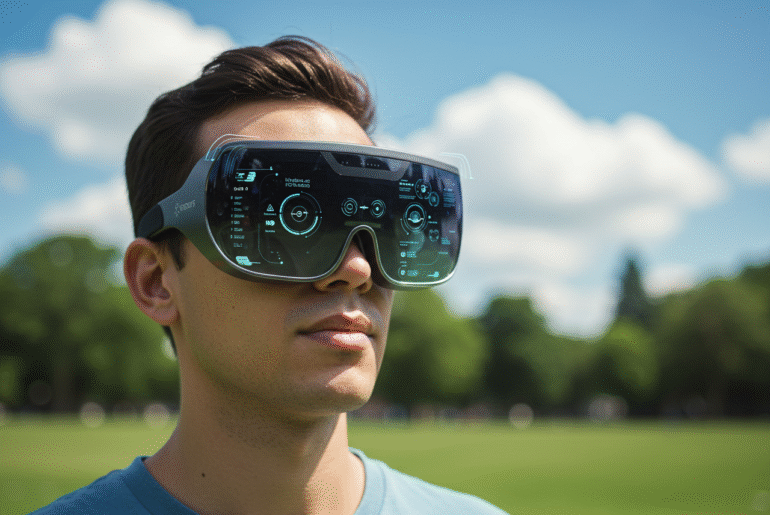This article may contain references to products or services from one or more of our advertisers or partners. We may receive compensation when you click on links to those products or services. Nonetheless, our opinions are our own.
The information presented in this article is accurate to the best of our knowledge at the time of publication. However, information is subject to change, and no guarantees are made about the continued accuracy or completeness of this content after its publication date.
- Why Augmented Reality Glasses Are Finally Ready for the Mainstream
- What’s Driving Momentum?
- Smart Buying in a Shifting Market
- Why Prices Have Dropped And Why That Matters
- Use Cases with Financial and Functional Return
- Recommendations for Informed Selection
- Addressing Common User Concerns
- Price vs. Value
- Frequently Asked Questions
- Recommended Reads
Why Augmented Reality Glasses Are Finally Ready for the Mainstream
As technology becomes increasingly integrated into our routines, wearable devices have shifted from luxury novelties to practical tools. Among these, augmented reality (AR) glasses are gaining attention for their potential to blend digital convenience with physical activity. Once associated with enterprise and niche tech showcases, AR glasses are now positioned for broader consumer adoption.
In a rapidly evolving wearable tech landscape, AR glasses have reached a rare price-performance balance that makes them more accessible than ever. For those watching the sector closely, whether as tech-forward consumers or financial decision-makers, knowing their practical benefits and current market window is increasingly relevant.
What’s Driving Momentum?
The increasing interest in AR wearables is tied to their ability to enhance everyday experiences without detaching users from their surroundings. Unlike virtual reality headsets, AR glasses overlay digital content directly onto the user’s environment, offering context without disconnection.
Factors Supporting Broader Adoption
- Contextual Utility: From displaying directions while walking to surfacing live translations when traveling, AR glasses offer functional benefits beyond novelty.
- Hands-Free Interactions: Notifications, reminders, and app updates appear directly within view, eliminating the need to glance at a phone.
- Integration with Broader Ecosystems: These devices can synchronize with smart home systems, fitness trackers, and productivity tools, streamlining digital interaction.
Several recent product launches from companies like XREAL (formerly Nreal), Rokid, and Vuzix have contributed to a more diverse selection, competitive pricing, and steadily improving functionality.

Smart Buying in a Shifting Market
With the AR glasses sector expanding quickly, comparing features is more meaningful than focusing solely on price. While lower costs make these wearables tempting, long-term utility depends on more than just affordability.
Comparative Factors That Shape Value
| Feature | What to Look For |
|---|---|
| Display Performance | High brightness and resolution for visibility in different lighting environments |
| Wearability | Lightweight frames and a comfortable design that supports extended use |
| Runtime Efficiency | Battery life suited for how frequently and how long the glasses will be worn |
| System Compatibility | Seamless pairing with iOS, Android, or relevant apps and services |
| Software Support | Ongoing firmware updates and broad app integration for sustained functionality |
Voted "Best Overall Budgeting App" by Forbes and WSJ
Monarch Money helps you budget, track spending, set goals, and plan your financial future—all in one app.
Get 50% OFF your first year with code MONARCHVIP
Why Prices Have Dropped And Why That Matters
The current pricing shift for AR glasses reflects larger industry cycles, not just seasonal promotions. Several factors are driving more competitive costs:
- Inventory Rotation: Manufacturers are preparing to release newer-generation models, which often results in markdowns on current stock.
- Consumer-Driven Competition: More players are entering the AR space, especially in Asia and North America, prompting brands to price aggressively.
- Retailer Incentives: Limited-time sales events and back-to-school tech promotions offer additional savings opportunities.
This pricing trend provides a narrow window for those seeking an entry point into AR wearables at a reduced financial threshold.
Use Cases with Financial and Functional Return
Beyond entertainment, AR glasses are emerging as practical tools that serve multiple purposes across daily life and work. Their appeal isn’t limited to early adopters; their functionality can yield measurable time savings, productivity enhancements, and convenience.
Real-World Use Cases
- Immersive Shopping Tools: Preview home décor or apparel in your space before purchasing through AR-supported retail apps.
- Smart Fitness Integration: Receive in-frame metrics while running or cycling, including pace, heart rate, or route overlays.
- Real-Time Navigation: Whether driving, walking, or using public transit, AR overlays help with directional accuracy without checking your phone.
- Smart Home Control: Adjust lighting, review security camera feeds, or change thermostat settings with a glance or a simple voice command.
- Remote Work Enhancements: Visual cues, floating displays, and collaborative AR environments support presentations and meetings without screens.
For professionals and consumers alike, these capabilities translate into improved efficiency, clearer communication, and faster decision-making.
Recommendations for Informed Selection
AR glasses are no longer a one-size-fits-all product. Buyers should align product features with personal goals and expected usage frequency.
Strategic Tips Before Purchasing
- Compare features, not just prices, among brands like XREAL, Rokid, and Vuzix.
- Opt for models with proven software ecosystems to avoid obsolescence.
- Choose devices that are lightweight and reviewed positively for long-term wear.
- Look into support policies, return windows, and warranty terms.
Addressing Common User Concerns
Despite their rising profile, AR glasses can present early adoption challenges. However, most common problems have straightforward fixes.
| Challenge | How to Address It |
|---|---|
| Inconsistent Connectivity | Ensure stable Bluetooth and Wi-Fi connections; reboot devices if necessary |
| Limited App Selection | Verify that the desired apps are supported before purchasing |
| Battery Drain | Adjust brightness, limit background processes, and enable power-saving modes |
Price vs. Value
In today’s environment, affordability is often mistaken for compromise. But in the case of AR glasses, price reductions are occurring at a time when functionality and software maturity are improving. This combination makes certain models a high-value purchase rather than a risky investment.
For those focused on performance, compatibility, and future-readiness, the current landscape presents opportunities to acquire cutting-edge AR devices that serve needs at more accessible price points.
Frequently Asked Questions
What sets AR glasses apart from other wearable tech?
AR glasses present digital data within the user’s natural field of view. Unlike smartwatches or earbuds, they provide visual overlays, enabling hands-free engagement with content, tools, or directions.
Why are prices lower than in previous years?
Manufacturers are phasing out older models to make way for new product lines. Increased competition and sales events are also contributing to lower retail pricing.
What are the practical benefits of AR glasses today?
- Visual productivity enhancements
- In-place virtual shopping
- Workout tracking and coaching
- Simplified travel and live translation
- Smart home integration with minimal friction
What factors should influence a purchasing decision?
- Comfort and wearability over long sessions
- Compatibility with mobile ecosystems
- App availability and long-term support
- Battery performance suited to intended usage
Where are the best AR glasses deals found?
Tech retailers such as Amazon, Best Buy, and brand-direct outlets (e.g., XREAL’s online store) frequently run promotions. Price tracking tools like CamelCamelCamel or Honey can alert you to fluctuations.
Are AR glasses worth the investment?
If the capabilities match your professional needs, travel habits, or tech lifestyle, many current models offer a strong return in utility for the cost, especially at their current pricing levels.

Reviewed and edited by Albert Fang.
See a typo or want to suggest an edit/revision to the content? Use the contact us form to provide feedback.
At FangWallet, we value editorial integrity and open collaboration in curating quality content for readers to enjoy. Much appreciated for the assist.
Did you like our article and find it insightful? We encourage sharing the article link with family and friends to benefit as well - better yet, sharing on social media. Thank you for the support! 🍉
Article Title: Why AR Glasses Are Finally Mainstream
https://fangwallet.com/2025/06/26/why-ar-glasses-are-finally-mainstream/The FangWallet Promise
FangWallet is an editorially independent resource - founded on breaking down challenging financial concepts for anyone to understand since 2014. While we adhere to editorial integrity, note that this post may contain references to products from our partners.
The FangWallet promise is always to have your best interest in mind and be transparent and honest about the financial picture.
Become an Insider

Subscribe to get a free daily budget planner printable to help get your money on track!
Make passive money the right way. No spam.
Editorial Disclaimer: The editorial content on this page is not provided by any of the companies mentioned. The opinions expressed here are the author's alone.
The content of this website is for informational purposes only and does not represent investment advice, or an offer or solicitation to buy or sell any security, investment, or product. Investors are encouraged to do their own due diligence, and, if necessary, consult professional advising before making any investment decisions. Investing involves a high degree of risk, and financial losses may occur including the potential loss of principal.
Source Citation References:
+ Inspo
There are no additional citations or references to note for this article at this time.











































